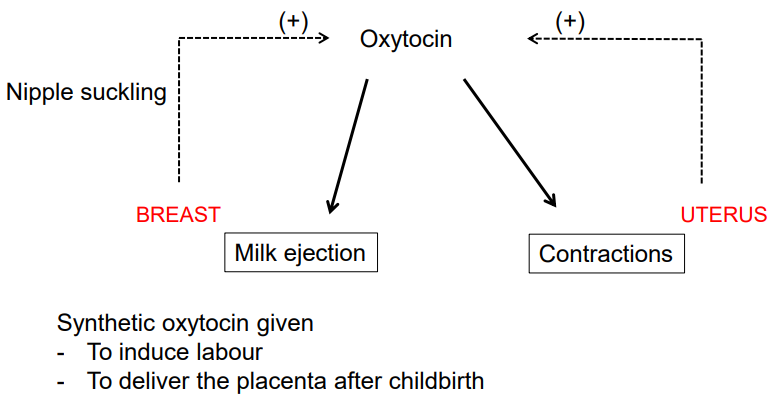1. Hypothalamus and pituitary gland
1/17
There's no tags or description
Looks like no tags are added yet.
Name | Mastery | Learn | Test | Matching | Spaced |
|---|
No study sessions yet.
18 Terms
Outline the anatomy of the pituitary & the hypothalamus.
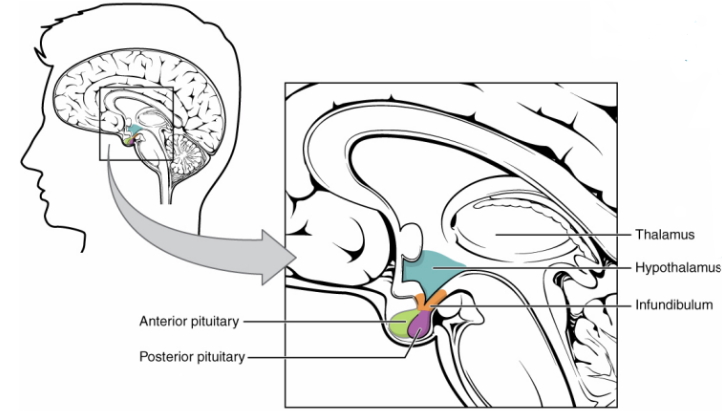
How does the hypothalamus control the anterior & posterior pituitary?
Anterior: ventral hypothalamus → hormones via portal veins → anterior pituitary → hormone release
Posterior: supraoptic & paraventricular nuclei → axons → posterior pituitary → release oxytocin & ADH
Act as separate endocrine glands
What hormones does the hypothalamus release to control the pituitary?
Hormones that influence the anterior pituitary:
GnRH – Gonadotropin-releasing hormone
CRH – Corticotropin-releasing hormone
TRH – Thyrotrophin-releasing hormone
TRH/Dopamine – Prolactin releasing/inhibiting factors
GHRH – Growth hormone releasing hormone
Somatostatin – Growth hormone release inhibiting hormone
Hormones that influence the posterior pituitary:
Vasopressin or antidiuretic hormone (ADH) or arginine vasopressin (AVP)
Oxytocin
What are the six principal hormones secreted by the anterior pituitary & their target organs?
FSH/LH – Follicle-stimulating hormone / Luteinizing hormone → Gonads
ACTH – Adrenocorticotrophic hormone → Adrenal gland
TSH – Thyroid-stimulating hormone → Thyroid gland
PRL – Prolactin → Mammary gland
GH – Growth hormone → Bone, soft tissue, viscera
Mnemonic: FLAT PG – helps remember the hormones
How are FSH & LH regulated, and what are the effects of their dysregulation?
FSH & LH are secreted by anterior pituitary → act on gonads (ovaries/testes)
Ovaries → oestrogen; testes → testosterone (from Leydig cells)
↑ Oestrogen/testosterone →
Direct negative feedback on anterior pituitary
Indirect negative feedback on hypothalamus (↓ GnRH)
GnRH is secreted in a pulsatile manner → regulates FSH & LH
Inhibin (from gonads) → directly inhibits FSH secretion
Hyposecretion (↓ oestrogen/testosterone) → amenorrhoea, sterility, delayed puberty
Hypersecretion (↑ oestrogen/testosterone) → premature sexual development in children
What are synthetic gonadorelin, GnRH analogues (e.g. buserelin, goserelin) & danazol used to treat & how do they work?
Infertility (alternative: recombinant LH & FSH injection)
Amenorrhoea (lack of menstruation)
Androgen-dependent prostatic cancer
Endometriosis
Precocious puberty
What does ACTH do & what are the effects of its hypo- & hypersecretion?
ACTH (Adrenocorticotrophic hormone) is secreted by the anterior pituitary
Stimulated by CRH from the hypothalamus
Acts on adrenal glands → ↑ secretion of cortisol (a glucocorticoid) & some sex hormones
Cortisol provides:
Direct negative feedback to ACTH
Indirect negative feedback to CRH
Secretion ↑ during stress (pain, fear, hypoglycaemia)
Hyposecretion → Addison’s disease
Hypersecretion → Cushing’s syndrome/disease
What does TSH do & what are the effects of its hypo- & hypersecretion?
TSH (Thyroid-stimulating hormone) is secreted by the anterior pituitary
Stimulates thyroid follicular cells → secrete T₄ (thyroxine) & T₃ (triiodothyronine)
T₃ & T₄ give direct negative feedback to the pituitary (not the hypothalamus)
Hyposecretion → cretinism (in infants) or hypothyroidism
Hypersecretion → Graves’ disease (autoimmune hyperthyroidism)
What are the roles of prolactin & effects of its hypo- & hypersecretion?
From anterior pituitary → breast development & milk production
Inhibited by dopamine
↑ in pregnancy & suckling
Hyposecretion → no lactation
Hypersecretion (e.g. tumour) → infertility, ↓ libido, galactorrhoea, breast enlargement, headaches
Treatment: dopamine agonists, surgery, radiotherapy
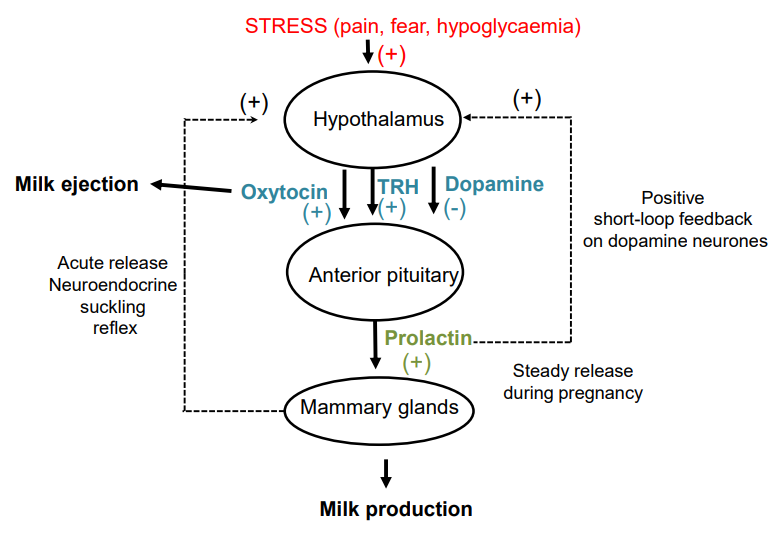
GH → acts on bone, cartilage, tissues; indirect effects via IGF from liver/kidneys
Regulated by GHRH (+) & somatostatin (−) from hypothalamus
GH inhibits insulin (diabetogenic effect)
Hyposecretion (childhood) → dwarfism (treat with GH)
Hypersecretion:
Pre-puberty → gigantism
Post-puberty → acromegaly
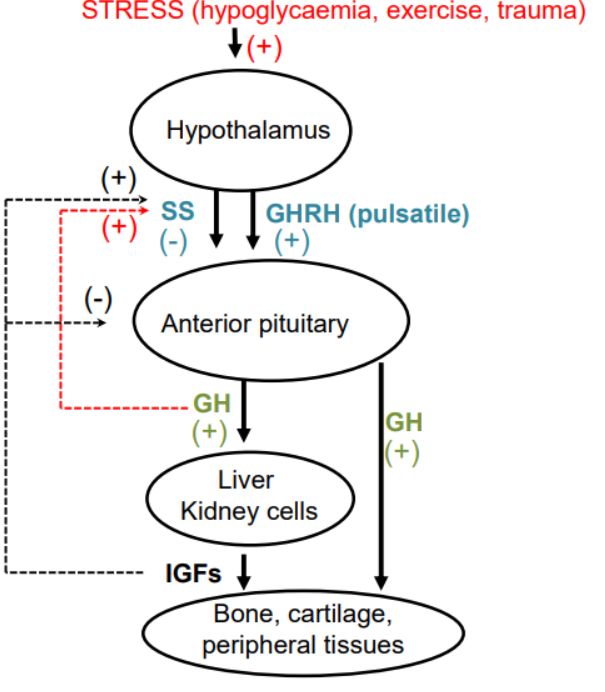
What causes acromegaly & what are its signs and symptoms?
Caused by post-puberty GH excess, usually from pituitary adenoma (>1 cm)
Enlarged hands, feet, heart, kidneys
Coarse facial features: large nose, jaw, lips, tongue; spaced teeth
Skin outgrowths, ↑ sweating
Voice changes, snoring, sleep apnoea
Carpal tunnel (tingling/numb fingers)
Hypertension, fatigue, ↑ blood glucose → diabetes
Headaches, vision changes
How is acromegaly treated?
Surgery to remove pituitary tumour
Somatostatin analogues (octreotide, lanreotide)
GH blocker (pegvisomant)
Radiotherapy
Dopamine agonists (bromocriptine, cabergoline) (tumours often express D2-dopamine receptors)
How do the hypothalamus and pituitary gland work together?
Hypothalamus hormones regulate pituitary hormone secretion
Anterior & posterior pituitary lobes function as separate endocrine glands
What regulates ADH release?
Hypothalamic osmoreceptors detect increased OP, and baroreceptors detect decreased BP.
Stimuli like severe pain, fear, nausea, anaesthesia, and some drugs increase ADH release.
Alcohol inhibits ADH release.
ADH causes vasoconstriction, increases water reabsorption in the kidneys, and raises BP and blood volume.
What causes & treats Diabetes Insipidus?
Caused by hyposecretion of AVP (Arginine Vasopressin), leading to large amounts of dilute urine & increased blood Na+ concentration.
Symptoms: polydipsia (excessive thirst) and polyuria (excessive urination).
Treatment: synthetic vasopressin or vasopressin analogues like desmopressin (Desmospray).
What causes and treats hypersecretion of AVP in Schwartz-Bartter syndrome?
Caused by small cell lung carcinoma, leading to excessive water retention, low plasma sodium, and high urine osmolarity.
Treatment: tumor removal or AVP antagonist (demeclocycline).
How does ADH (AVP) work, and what happens when blocked by an antagonist?
ADH binds to a receptor, activating G proteins and increasing cyclic AMP. This activates protein kinase A, which stimulates water reabsorption.
If blocked by an AVP antagonist, this process is inhibited, leading to symptoms like in Schwartz-Bartter syndrome.
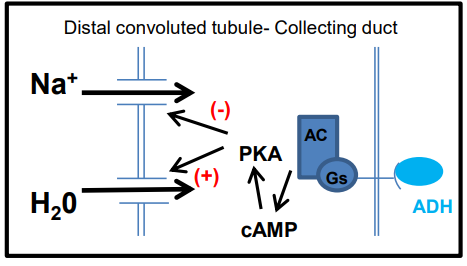
How does oxytocin work during childbirth and breastfeeding?
Nipple suckling and uterine contractions trigger the release of oxytocin from the posterior pituitary.
Oxytocin stimulates uterine contractions (during labor) and milk ejection (during breastfeeding).
This creates a positive feedback loop, as contractions and suckling continue to trigger more oxytocin release.
